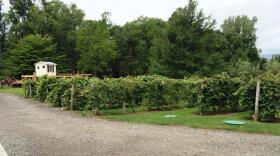Michigan’s wine scene is an emerging one, and it’s more diverse than you might think. That’s according to Wine Enthusiast Magazine, who selected Michigan as one of its “wine regions on the rise” this year.
The Executive Editor of Wine Enthusiast is Susan Kostrzewa, and she herself is a Michigander, originally from Traverse City.
“I’ve had my eye on Michigan for a long time, having grown up there, and I think the quality of the wine has really improved on a pretty massive level over the last, maybe, five years. And what gained our attention was that these are wines that are being entered into wine competitions across the country, they’re being tasted blind and they’re scoring very well,” says Kostrzewa.
Michigan’s commercial wineries bottle more than 2.3 million gallons every year, which ranks the state 10th in U.S. wine production.
At the time of WKAR’s interview with Kostrzewa, she was aware of four AVAs, or American Viticultural Areas, in Michigan: Fennville, Lake Michigan Shore, Leelanau Peninsula and Old Mission Peninsula. But very recently, a fifth has been added, called “Tip of the Mitt,” which includes the counties of Charlevoix, Emmet, Cheboygan, Presque Isle, Alpena, and Antrim, or portions thereof. Together, the five regions house 121 wineries.
“Half of Michigan’s wines are grown in the Leelanau Peninsula and Old Mission Peninsula AVAs, so a lot of its being made in northern Michigan, but there are other areas that are becoming known for wine and that are growing some interesting things,” she says.
Not many people realize how many natural advantages Michigan has for growing wine, Kostrzewa says. Not only is the soil good, but the climate is well-suited. Especially up north in the Leelanau and Old Mission regions which sit at 45 degrees latitude, just like some of the famous wine regions in France.
“It’s a lot more of a moderate climate for growing than people realize because we think of Michigan as this very cold place, and it is, but it has a lake effect that really moderates the temperatures and protects the grapes more than people would think -in the same way that in Bordeaux and Burgundy and Alsace you have that nice balance of weather which really helps create some really elegant grapes,” says Kostrzewa.
Michigan is known for producing sweeter wines, like Riesling, and dessert wines, like ice wine- which is made from grapes that have been left on the vine until after the first frost, so the sugar in the grapes is very concentrated. But Kostrzewa says that while Michigan’s sweet wines are high quality, they’re not the only great wines the state has to offer.
“What’s happening now is the regular still Rieslings are being made in a drier style, so first of all you’re getting these really nice, elegant white wines that have a dryness and what we call balance, meaning nothing overpowers, the sweetness doesn’t overpower, the flavors are all integrated, so that’s a surprise. And there are other wines being made now that are really surprising and that’s red wines. Because, you know, it’s a cold climate so it’s not always easy to make red wines in those areas, but Michigan is making some really nice ones now. They’re doing Merlots, Cabernet Francs, and some other really nice reds, so you’d be surprised at some of the quality of what you’re getting on that side as well.”
So what should you try if you’re new to the world of Michigan wines, or want to explore beyond the sweet ones? Kostrzewa has some suggestions.
“I love Mawby, which is a Leelanau producer and they do sparkling wine that I think is really really good so I would recommend that. Mari Vineyards, which is up in Traverse City, is making red wine and they’ve got a process they’re doing where they’re doing heat-capturing canopies, so that they’re allowing the grapes to mature a little bit more even though it is a little bit of a cooler climate, so I’d say try some of the reds from them. There’s also Pinot Gris, Pinot Blanc, and the last one I’ve mentioned is Gewurztraminer, which is a German variety, and several producers throughout the state are making it and I think they’re doing a really great job. So that’s kind of my grape right now in Michigan that I’m watching and getting really excited about.”
For more recommendations of Michigan wineries to try, see the Wine Enthusiast’s article, Wine Regions on the Rise.





